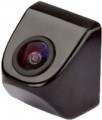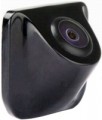Instalation type
Standard installation method and location provided for by the camera design.
-
Universal. This installation method can be conventionally called “external” - the camera is placed on a stand that is screwed to a particular surface, and the body is completely located outside. This option is generally universal and can be used regardless of the car brand, although there are standard cameras (see below) with this installation.
-
Mortise. Cameras installed in specially made sockets for them. They are usually round in shape, and for installation it is enough to drill a hole of the appropriate size in the car body. Also, as a rule, they are universal.
—
Screw. Cameras designed to be installed using a screw mount (hence the name). They are quite simple and easy to install - just make a hole for a screw in the body, and the required hole size is noticeably smaller than that of mortise models. Most often they are universal.
—
License plate frame. Devices that are frames for license plates with built-in rear view cameras. They are convenient because they do not require special installation work - the structure is simply installed instead of the standard frame, on the same fastenings. At the same time, it is worth considering that frames for numbers can have different formats and, accordingly, the size and c
...onfiguration of fasteners; This point must be clarified before purchasing.
— In the license plate light. Cameras mounted in the license plate light. They often include not only a camera, but also a lamp to illuminate the license plates. License plate lamps on different cars have different designs; accordingly, models of this type are made mostly standard (see below).
- In the trunk handle. Models that consist of a trunk handle with a camera installed in it and are mounted instead of the complete handle. They are made only by regular ones (see below).
- In the emblem. Models of this type can represent either separate cameras built into the “nameplate” or emblems supplemented with cameras and installed instead of the factory emblem. By definition, they are only regular (see below).
— In the radiator grille. In the vast majority of cars, the engine and, accordingly, the radiator are located at the front; Accordingly, this option is typical for forward-looking cameras (see “View type”). Most of these models are standard (see below).
- At the stop sign. The optics are made in the form of a brake light. As a rule, such cameras are made for a specific make and model of car. The device itself is installed in place of one of the standard brake light headlights (right, left or center). At the same time, during the installation process there is no need to make holes in the body elements or turn off the license plate light. The camera in the brake light body does not violate the integrity of the design of the stern, laconically blending into the image of the exterior.Sensor size
The physical size of the photosensitive element of a camera. It is usually measured diagonally and is indicated in inches — more precisely, fractional parts of an inch. The larger the sensor, the larger the size of each individual dot (pixel) on it, the more light enters each pixel, and the easier it is to ensure high image quality with a minimum of noise (especially when it comes to shooting at dusk). However you need to remember that only matrices of the same type and resolution can be compared with each other in size. And a large sensor is not always a guarantee of quality — a lot depends on the rest of the hardware of the camera, the quality of its installation and other factors. However, the large size of the sensor usually indicates a high class camera.
Video resolution (TVL)
Although modern electronics are dominated by digital standards, car reversing cameras still use an analogue signal transmission format. This is due to compatibility requirements: such video allows you to use fairly simple screens. And although its quality loses to digital, it is quite enough for most of the tasks facing this class of auto electronics.
An analogue video signal has a size in horizontal and vertical dots. But since the number of vertical dots has a strictly defined number of 625 (in the PAL and NTSC colour system), resolution is usually indicated only by the number of horizontal dots (TV lines).
In fact, this parameter describes the quality of the image that is displayed directly on the screen connected to the camera. There are models with a value of
480,
500,
520,
540,
560 TVL and even
higher resolution in TVL. This is important for models with wide viewing angles (see below). On the other hand, in order to use all the features of a camera with numerous TV lines, a screen corresponding to these features is also required; For more details on compatibility with the screen, see specialized sources.
Сolour encoding system
The colour system refers to the format in which colour information is transmitted in an analogue video signal. In modern reversing cameras, the European PAL system or the American NTSC are most often used. It makes no sense to describe them in detail — suffice it to say that for the normal operation of the camera you need a radio tape recorder (or other device with a screen on which the image is displayed) with support for the same colour system. However, incompatibility in this parameter is not fatal — with such a connection, the image will only turn from colour to black and white (in extreme cases, its overall quality will slightly deteriorate).
Signal-to-noise ratio
This parameter describes the total amount of interference in the video output from the camera. The higher the signal-to-noise ratio (that is, the ratio of the useful signal level to the level of extraneous interference) — the better the image will be, the less distortion it will have. The minimum level for modern cameras is considered to be 40 dB — with it, the “picture” is reproduced with minor noise that does not significantly affect its perception. And in the most advanced models, this figure can reach 48 – 50 dB — such an image for the human eye is almost indistinguishable from the perfect one.
Of course, in fact, the quality of the image also depends on the capabilities of the screen on which it is displayed, however, even the best screen will not save a “noisy” camera.

